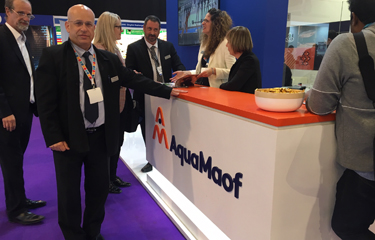AquaMaof Aquaculture Technologies Vice President of Marketing and Sales Shai Silbermann has a message to potential aquaculture investors: stop waiting.
Silbermann is an evangelist of recirculating aquaculture systems (RAS). Speaking to SeafoodSource at the 2019 Seafood Expo Global, he said those waiting for more proof that RAS can be profitable haven’t looked close enough at what his company has accomplished.
“Our technology is receiving interest all over the world. Today, we have five locations with RAS and a very healthy pipeline of projects,” he said.
Rosh Haayin, Israel-based AquaMaof is a developer and manufacturer of aquaculture technology and RAS projects. Silbermann said the company is increasingly moving into partial ownership or joint ventures of RAS projects both to reassure investors and to capitalize on the promise of the technology.
“Everybody understands now there is a window of opportunity [with RAS],” he said. “Maybe three years ago, everybody was talking about a 2,000-ton project like, ‘Wow, that’s a huge project.’ Now they’re talking about 60,000-ton projects. Three years ago, we didn’t have one 10,000-ton project. Now there are three projects with 10,000-ton projected capacity.”
There are a number of factors that are tilting the field in favor of RAS, according to Silbermann. The first is simple geography – the amount of space left on coastlines for net-pen aquaculture is limited, and RAS allows developers to pick the location of their choosing, allowing them to produce fish closer to major markets.
“In order to invest in cage culture, you need to get permits and to get permits means you need to pay a lot of money for those permits. Like, for 1,000 tons of production, you need to pay USD 1 million [EUR 895 million] to start with, and I’ve heard higher numbers than that,” he said. “Also, with RAS, you don’t need to be near a big source of water. Because of that, you can locate near big cities. Transportation costs are cut drastically – currently from the two big [salmon] production centers in the world, Norway and Chile, the cost of transportation is between USD 1.00 and USD 3.00 [EUR 0.90 and EUR 2.69] just for transport.”
The second reason RAS is primed for success is increased consumer demand for what Silbermann called “clean” seafood.
“People are concerned there fewer fish left in the water, and … about health aspects, stuff like heavy metals. [Wild-capture seafood] is perceived now as not so healthy. When I was a kid, it was very healthy to eat fish from the sea, but these days people are not quite sure,” Silbermann said.
The third reason is the narrowing differential in the cost of production between RAS and more traditional types of fish-farming. While the costs of RAS technology are not insignificant, they allow producers to “avoid a lot of problems,” Silbermann said.
“You have full control of the water. You don’t need chemicals or antibiotics – you don’t need to do preventative action. So assuming you enact very strict biosecurity protocols, you avoid a lot of problems and you have very low mortality,” he said. “With that, instead of USD 4.50 to USD 5.00 [EUR 4.03 to EUR 4.48] per kilo in direct costs, you can do USD 3.00 [EUR 2.69]. Multiply that by thousands and you understand how much money this means.”
Silbermann’s final reason for investing in RAS – and what he believes is the most compelling one – is that proof of concept already exists. It built and continues to own a stake in the Global Fish RAS hatchery, smolt, and grow-out facility for Atlantic salmon in Plonsk, Poland. Silbermann said the company uses that facility as a model to show potential investors and clients how its technology works and why it’s such a good investment. Seeing it has helped land numerous new RAS-related contracts, he said.
“We understand that people need to do their due diligence. We’ve had lot of failures with other technologies so we know the concept is not proven in everyone’s minds yet,” he said. “But what people see when they visit is how we approach and operate the technology. Our difference comes from approaching everything from the angle of fish production. And that we’re this Israeli technology firm that is coming from the desert – where there is not a lot of water – and making this work.”
The pitch has worked, Silbermann said, as AquaMaof has recently announced several other new projects, including a EUR 25 million (USD 28.7 million), 2,500-metric-ton capacity Atlantic salmon farm in Vologda Oblast, Russia; a contract with Grieg NL to build the world’s largest indoor salmon aquaculture facility in Newfoundland; and a Pure Salmon project in Virginia, U.S.A.
“Everyone is starting to realize there is no other choice. Population and consumption are going up and up, so somebody needs to fill this gap, which is becoming huge,” Silbermann said. “A project that’s producing 60,000 tons of fish is now just a drip in the ocean – we will need to produce millions of tons of fish to meet demand.”
The opportunity is so large that Silbermann said he’s not even upset when a competitor lands a contract.
“There’s space for everybody. There’s a place for everybody. I’m very glad when my competitors succeed because I think it supports the concept of RAS, and I think if we’re going succeed, it will be by succeeding together by getting the attention of investors. If that happens, everybody benefits,” he said.
Silbermann said he’s realistic about the likely hurdles on the way to success, but that progress toward greater adoption of RAS is inevitable.
“There will be problems, and when they arise, we will address them. We feel very confident with our technology, and the ‘why’ behind investing in our technology. We want to be part of the success story of RAS and also to gain profit for our company,” Silbermann said. “This is the future, and it’s already happening now.”







